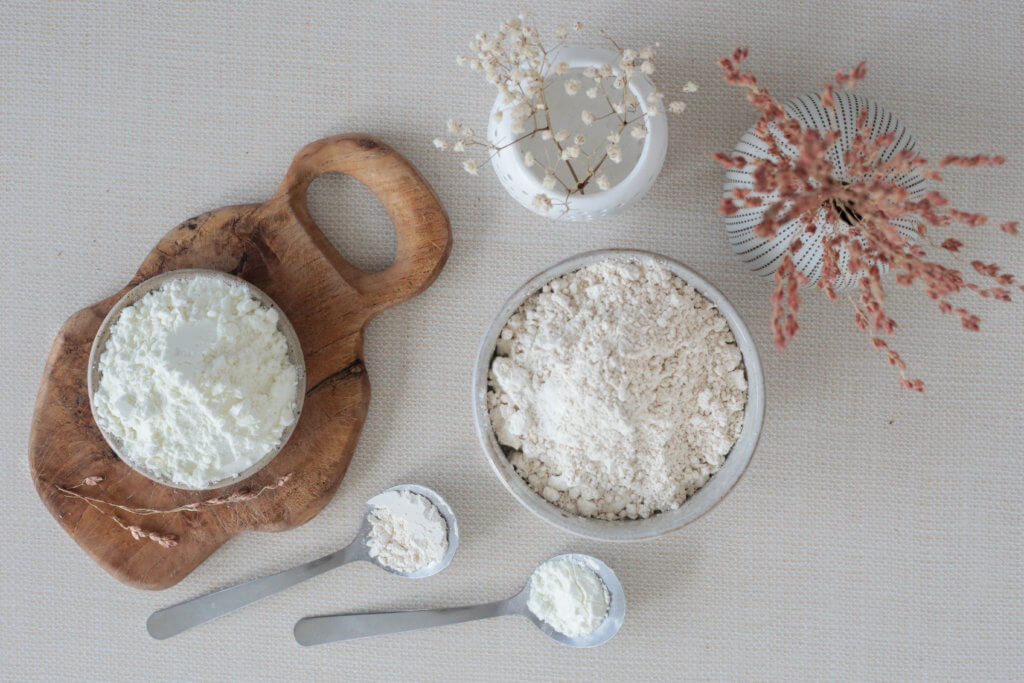

When it comes to cleansing, we often hear words like: removing, eliminating, and purifying.
Words like replenishing, nourishing, and restoring aren’t usually part of the conversation —but this recipe shows why they should be.
A way to transform our approach
Typical body/facial cleansers work through actions of extraction and elimination.
It helps you achieve the goal of having clean skin, but using methods that leave the skin stripped of its resources. And that’s unsustainable. There’s going to be an imbalance.
Instead we can consider a regenerative approach to cleansing – using methods that prioritize replenishment and nourishment. So that you can balance the want for clean skin, with the needs of healthy skin.
Here’s what regenerative cleansing looks like, through the lens of this recipe:
- Being pro-biotic
“Cleansing” has come to mean removing microbes from the skin. But we are beginning to recognise, like the gut, our skin too depends on a healthy, diverse microbiome.Oats are a pre-biotic, which means it feeds healthy bacteria on the skin – which do the work of cleaning by keeping the numbers of pathogens and opportunistic bacteria in-balance.
- Supporting natural exfoliation.
Exfoliation is a natural process of renewal – but it’s about strengthening the skin barrier, not stripping it and depleting it.The lactic acid in goat’s milk removes dead-skin cell accumulation on the surface of the skin –and– restores moisture (milk fat) into the skin. It fortifies. the skin barrier, and the acid mantle. because goat milk has the same pH as the skin, it supports the acid mantle.
- Clearing excess oils
Soap, and certainly over-washing, can leave the skin stripped of its own natural resources: oils, microbes, acid-mantle.
Saponin-rich herbs have a soap-like action. They clean by helping to capture and remove excess oils, dirt, and bacteria. Oats is an incredible saponin-rich herb, full of lipids, pre-biotics, nourishment. And it also acts as a buffering agent which means it helps the skin maintain a normal pH. Oats are seriously underrated. It cleans your skin, and at the same time moistens the skin barrier, supports the microbiome and maintains the skin’s pH.

Oat & Goat Cleanser
A powder-to-cream cleanser that cleans and replenishes the skin. Gentle enough to use daily, leave on as a mask.
Ingredients:
- 1 part full-fat goat milk powder (amazon)
- 1 part colloidal oatmeal (amazon),
or finely ground rolled oats* “part” can be any unit of measure, ie: teaspoon, tablespoon, cup, ounce.
For this recipe, it can be 1/4 cup goat milk powder, 1/4 cup colloidal oatmeal. All depending on how much or how little you want to make.
Step 1
Combine the goat milk powder and colloidal oatmeal together and mix well. Store in a labeled container.
Step 2
To use: scoop out 1 tbsp into a small bowl. Activate with droplets of warm water to form a creamy paste.
If you are wearing makeup and/or sunscreen, remove that first with an oil cleanser, ie: jojoba oil + a soft damp cloth.
Massage the creamy oat & goat cleanser on your face (body) let it sit for 10-minutes and then wash off.
I like to apply it onto my skin just before getting into the shower, and then I’ll only wet/wash my face just at the end of my shower.
Thoughts?
Cleansers are a fascinating topic because ultimately – it’s a solution to a problem that was never well-defined.
Why do we need to clean our face with a product every day? What was the problem that facial cleansers were created to solve?
Cleansing has become so ingrained – using a cleanser feels necessary. It’s a standard, daily practice. The only question we ask, is: what cleanser is best?
But, something that’s interesting to consider is: do I need a product to clean my face at all?
James Hamblin is a doctor and journalist who made waves back in 2016 when he took this “cleansing” question a step further and asked – why are we cleaning our body at all? He decided to embark on his own research study – and stopped showering for 5 years – to see what’s happens.
”Because, evolutionarily, why would we be so disgusting that we need constant cleaning? And constant moisturizing and/or de-oiling? If we do more to allow our oil glands and bacteria to equilibrate, the theory goes, the skin should stop fluctuating between oily and dry.”
The shocking reveal (spoiler alert) is that… nothing happened. His face didn’t break out. His health didn’t deteriorate. Even his social status didn’t suffer. In fact, he found that once his skin rebalanced from cleanser-withdrawal, he didn’t stink. And his skin was just naturally clean, and healthy.
You know, when I was writing my book on natural homemade skin – my publishers expressed concern that some of my recipes were too simple… They wondered if “people might feel like its not enough”
Even within the natural/wellness/health space: there’s still this idea that we need to do more to our skin. It’s interesting to wonder – where did this come from? And is it true?
Certainly the beauty industry and capitalism feeds this idea of needing more. More product. More ingredients more steps…
And yet, that has’t felt good. And for a lot of us, it hasn’t worked.
I’ll tell you this – I didn’t change my recipes. And I’m still at it…
This Oat + Goat Milk is definitely simple. But it feels really good. And it approaches cleansing – in a nourishing way.
What about you? What do you enjoy for cleansing? Would love to hear your thoughts!

One response to “Regenerative Cleansing: Oat & Goat Milk Cleanser”
I think it’s so interesting that you actually decided to dive into this topic and pose the question on cleaning. I too was a consumer who was constantly searching for products that were better than something I was using previously, and none of it really worked. If anything it further damaged my skin. In an effort to become less of a consumer and more of a creator I decided to buy your book. I’ve been using your fresh face routine and my skin feels so much better. It’s the softest it’s ever been…and the routine is so so simple. I enjoy knowing that I can create things that are healthy and that I know exactly what is in them. I feel so inspired by this journey that I’m trying to find more courses and education platforms to learn more about plants, essential oils, and making my own things at home.